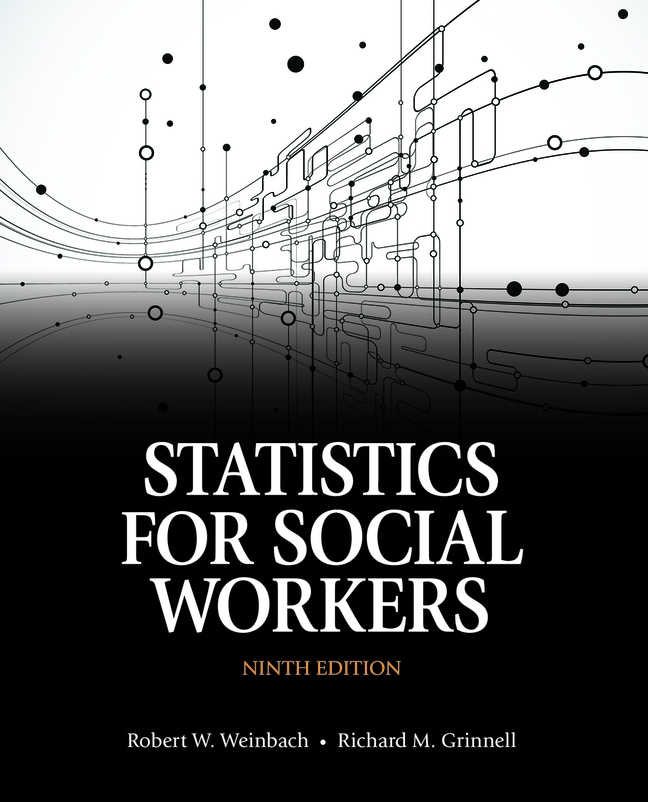
Statistics for Social Workers, 9th edition
Your access includes:
- Search, highlight, notes, and more
- Easily create flashcards
- Use the app for access anywhere
- 14-day refund guarantee
$10.99per month
Minimum 4-month term, pay monthly or pay $43.96 upfront
Learn more, spend less
-
Study simpler and faster
Use flashcards and other study tools in your eTextbook
-
Find it fast
Quickly navigate your eTextbook with search
-
Stay organized
Access all your eTextbooks in one place
-
Easily continue access
Keep learning with auto-renew
Overview
In this Section:
I) Brief Table of Contents
II) Detailed Table of Contents
I) Brief Table of Contents
1. Introduction
2. Frequency Distributions and Graphs
3. Measures of Central Tendency and Variability
4. Normal Distributions
5. Testing Hypotheses
6. Sampling Distributions
7. t Tests and Analysis of Variance
8. The Chi-Square Test of Association between Variables
9. Correlation
10. Regression
11. Other Ways That Statistical Analyses Contribute to Evidence-Based Practice
II) Detailed Table of Contents
1. Introduction
Useful Terms You Will Need to Know
Measurement iSSUES
Additional Measurement Classifications
Research Hypotheses
Classification of Variables and Their Relationship
Categories of Statistical Analyses
Statistics and data collection
Research designs and statistics
2. Frequency Distributions and Graphs
Frequency Distributions
Grouped Frequency Distributions
Using Frequency Distributions to Analyze Data
Misrepresentation of Data
Graphs
A Caution: Computer-generated graphs
3. Measures of Central Tendency and Variability
Measures of Central Tendency
Measures of Variability
Other Uses for Central Tendency and Variability
4. Normal Distributions
Skewness
Kurtosis
The Normal Curve
The Standard Normal Distribution
Converting Raw Scores to z Scores and Percentiles
Deriving raw Scores From Percentiles
5. Testing Hypotheses
Alternative Explanations for Relationships Within Samples
Probability and Inference
Refuting Sampling Error
Statistical Significance
Testing the Null Hypothesis
Errors in Drawing Conclusions About Relationships
Statistically Significant Relationships and Meaningful Findings
The Hypothesis Testing process
6. Sampling Distributions
Sample Size and Sampling Error
What are Sampling Distribution?
Rejection Regions and hypothesis testing
Estimating Parameters
Selecting Statistical Tests
Deciding Which Test to use
7. t Tests and Analysis of Variance
The use of t Tests
The One-sample t Test
The Dependent t Test
The Independent tTest
Misuse of t tests
Simple Analysis of Variance (Simple Anova)
Multivariate Analysis of Variance
8. The Chi-Square Test of Association between Variables
When Chi-Square is Appropriate
Cross-Tabulation Tables
Using Chi-Square
When Chi-square is not appropriate
Using chi-square in social work practice
Cross-Tabulation With Three or More Variables
Special Applications of The Chi-Square Formula
9. Correlation
Uses of Correlation
Scattergrams
Nonperfect Correlations
Interpreting Linear Correlations
Using Correlation for inference
Pearson'S r
Nonparametric Alternatives to Pearson'S r
Correlation With Three or More Variables
Other Multivariate analyses That use Correlation
10. Regression
Prediction and Evidence-Based Practice
Prediction and Statistical Analysis
What is Simple Linear Regression?
Computation of the Regression Equation
More About the Regression Line
Interpreting Results
Using regression in social work practice
When is regression analysis appropriate
Regression With Three or More Variables
Other Types of Regression Analyses
11. Other Ways That Statistical Analyses Contribute to Evidence-Based Practice
Meta-analyses
Program evaluations
Single-System designs
Published by Pearson (February 13th 2014) - Copyright © 2015
ISBN-13: 9780205867257
Subject: Social Work & Human Services
Category: Research Methods in Social Work
Your questions answered
When you purchase an eTextbook subscription, it will last 4 months. You can renew your subscription by selecting Extend subscription on the Manage subscription page in My account before your initial term ends.
If you extend your subscription, we'll automatically charge you every month. If you made a one‑time payment for your initial 4‑month term, you'll now pay monthly. To make sure your learning is uninterrupted, please check your card details.
To avoid the next payment charge, select Cancel subscription on the Manage subscription page in My account before the renewal date. You can subscribe again in the future by purchasing another eTextbook subscription.
When you purchase a Channels subscription it will last 1 month, 3 months or 12 months, depending on the plan you chose. Your subscription will automatically renew at the end of your term unless you cancel it.
We use your credit card to renew your subscription automatically. To make sure your learning is uninterrupted, please check your card details.